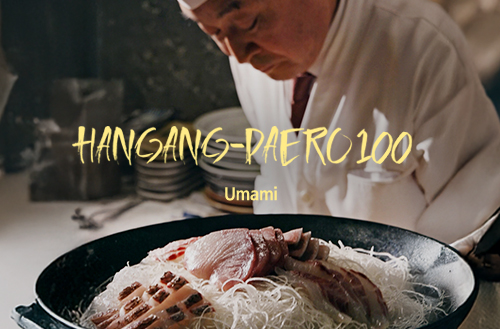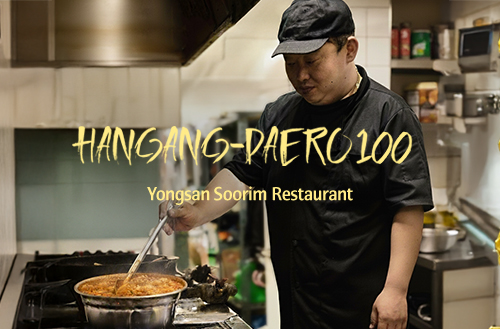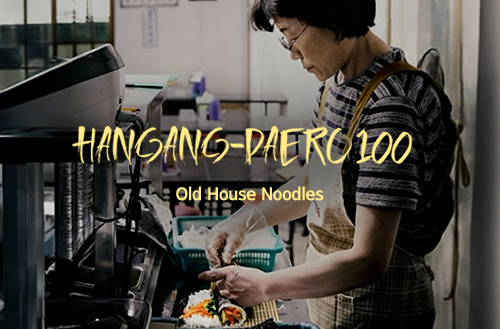

-
-
- 메일 공유
-
https://stories.amorepacific.com/en/amorepacific-meeting-jeong-im-han-the-owner-of-poongnyeon-samgyetang
Meeting Jeong-im Han, the Owner of ‘Poongnyeon Samgyetang’
Continuing a Legacy of Flavor Since 1990

For over 30 years, Deok-chan Kim and Jeong-im Han have been dedicated to perfecting one thing: Samgyetang, or Korean ginseng chicken soup. On the cusp of summer's end, as preparations for Malbok—the final day of the hottest part of the Korean summer—were in full swing, AmoreStories sat down with Jeong-im Han, the owner of ‘Poongnyeon Samgyetang,’ to explore her journey.
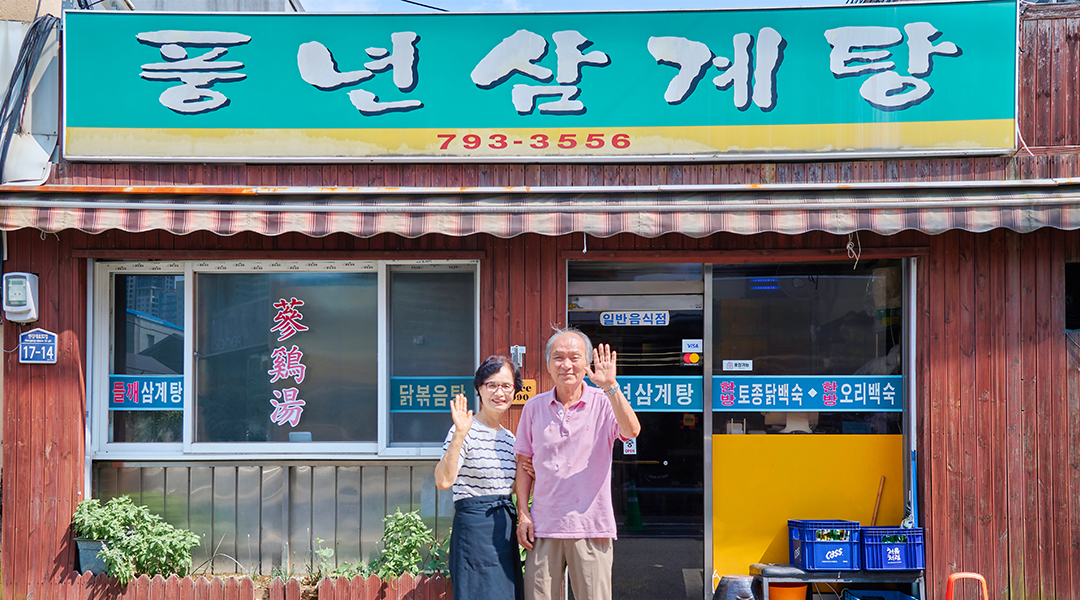
In front of ‘Poongnyeon Samgyetang,’ Mr. Deok-chan Kim and Mrs. Jeong-im Han
From Housewife to Restaurant Owner: A Journey
It all started in 1990 when you opened Poongnyeon Samgyetang.
Could you tell us how that came about?
I was an ordinary housewife back then. My husband had left his job at a state-owned company for personal reasons and was running a billiard hall. One day, my cousin, who owned a Samgyetang restaurant in Busan, visited us in Seoul and suggested we try opening a Samgyetang place. I was hesitant; my husband wasn't much of a cook, and the billiard hall was doing well. But my husband was intrigued—perhaps because the indoor smoking policy at the time made the billiard hall environment unpleasant, filled with constant smoke. Plus, my cousin’s restaurant was famous in Busan, which made the idea even more appealing to him. He kept persuading me, and eventually, I agreed. We both went down to Busan to learn the ropes. Since a restaurant requires cooking, I had to take the lead. I was initially worried, but I’ve always liked cooking and tend to pick things up quickly, so I learned everything faster than I expected. I made it my mission to master every aspect since I was the one who would be cooking. From there, it took about three months to get the restaurant up and running—a whirlwind process.
Why did you choose Yongsan as your location?
Yongsan was the only place we knew well. My husband had lived here since he was a child, and I had been here since we got married in 1975. My husband wanted to start big in an area with much foot traffic, but I was apprehensive. Such places have high rent and labor costs, and there was no guarantee of success, even with a proven recipe. I wanted to start somewhere familiar, even if it wasn’t busy. At the time, there wasn’t another Samgyetang place in the neighborhood, and there were plenty of elderly residents who I thought might appreciate it. We initially planned to stay in Yongsan for just three years and then move, but somehow, we ended up running the business here for over 30 years.
What was Yongsan like back then?
Back then, there was a large wholesale produce market where the electronics market now stands. Being in the heart of Seoul, with excellent transportation links, it was bustling with activity. However, the neighborhood was pretty dilapidated—so much so that you wouldn’t believe such a place existed in Seoul. It was filled with old shanties, a ‘rural village in the city.’ It was a place where everyone knew each other, and in the fall, we would make and share rice cakes like neighbors in a rural village. I doubt there was any other place in Seoul as warm and friendly as Yongsan. I loved Yongsan for that. However, as the area developed, shops replaced houses, and residents gradually moved away. Only a few of the original people remain. Thinking back, it makes me nostalgic and a bit sad.
Did you have any goals before opening?
Before opening, we rarely ate out; we always cooked at home. So, we did about two months of market research before opening. I carried my child on my back and visited every nearby restaurant, checking out their food, customer numbers, and interiors. Based on that, I set a goal: selling ‘30 bowls a day.’ At the time, an essential meal cost about 1,500 won, but Samgyetang was 4,000 won—a premium dish even then. I thought, “If we sell 30 bowls daily, we can get by. Let’s aim for just 30 bowls daily.”
Why did you name the restaurant ‘Poongnyeon Samgyetang’?
A fortune teller set up a mat in the neighborhood back then. As I passed by one day, I asked out of curiosity if they had a good name for a restaurant I was about to open. He said the character ‘Poong’ suited me well. I thought about names with ‘Poong’ and landed on ‘Poongnyeon,’ which means ‘bountiful year’ in Korean. It seemed fitting, especially with Samgyetang made with glutinous rice, so that’s how ‘Poongnyeon Samgyetang’ came to be.
Business Is All About Endurance
What was the response like on your opening day?
On our first day, we had an overwhelming number of customers. My husband went around to all the local offices, handing out ashtrays as opening gifts. Many of the neighborhood residents and regulars from the billiard hall also came. It felt like a swarm of people. I was completely overwhelmed since I had never run a business before and had no idea so many people would come. Luckily, my cousin and my family were there to help, so we managed to get through it.
In the beginning, there’s always what they call the ‘opening effect,’ where many customers come, but I knew it wouldn’t last long. I worked hard, thinking, “Let’s ensure each customer brings one more next time.”
You went from being a housewife to running a business.
Wasn’t it difficult?
It was incredibly tough. I had been a homemaker my whole life, so jumping into running a business was a huge challenge. I worked seven days a week, starting at 5 a.m. daily without rest. After about a month, I felt like I couldn’t go on. I was utterly drained, both physically and mentally. I was so exhausted that I couldn’t even think about money. At the time, my youngest child was just two years old, and we ended up living with my in-laws after initially leaving the child with them. As I pushed through the chaos of each day, I gradually became more adept at managing the work, and after about three months, things became much more manageable.
How did you and your husband divide the work?
When the chickens were delivered at dawn, my husband cleaned and prepped them, removing any excess fat and soaking the glutinous rice. Then, I would stuff the chickens and cook them. Initially, we didn’t work well together, but we developed a seamless routine over time.
Has business always been good?
Given the nature of our dish, business was always strong in the summer. However, after summer, the off-season was painfully long. We often couldn’t afford to hire staff during those times, so my husband and I had to manage independently. Many Samgyetang restaurants don’t last because the off-season is so challenging. However, as we persisted through those slow periods, we built up a loyal customer base, and eventually, even the off-season became more profitable. I’ve learned that nothing comes easily.
Has the restaurant’s exterior changed much since you first opened?
When we first opened, we laid traditional Korean roof tiles to give it a Hanok feel. It had a certain charm and elegance. We also had a beautiful neon sign. But the tiles started falling off over time, and the sign would short out whenever it rained. We eventually removed the tiles and replaced the sign, which gave us the current look. The restaurant looked quite lovely back then; it’s a pity we didn’t take any photos of it.
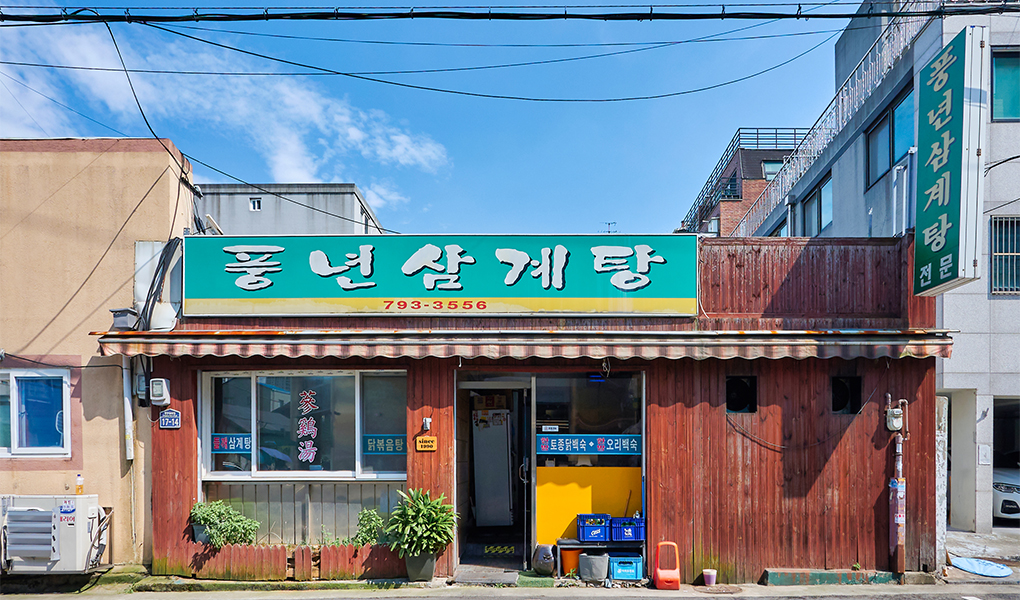
Current Look of Poongnyeon Samgyetang
Why Poongnyeon Samgyetang Doesn’t Raise Its Prices
in This Era of High Inflation
Can you introduce the three best-selling dishes at Poongnyeon Samgyetang?
Unsurprisingly, our top seller is the classic Samgyetang. Our Perilla Seed Samgyetang follows closely behind, and our Braised Spicy Chicken is third.
What distinguishes your Samgyetang from others?
The most significant difference lies in the salt we use. We use aged salt, which is quite unique. If you go up to the roof of our restaurant, you'll see jars filled with salt. Most of this salt has been aged for about five to six years, but some jars contain salt that’s over ten years old. When you store sea salt in jars, the brine gradually drains away, removing the bitterness and leaving a subtly sweet aftertaste. Harmful substances are eliminated when you roast this salt, and the flavor becomes much richer. The salt itself becomes much firmer as well. When we use this salt to cook our Samgyetang, the difference in taste is remarkable.
We also make our Samgyetang broth by boiling chicken feet for an extended period, which gives it a deeper, richer flavor. We only use fresh chickens delivered that day. Rather than adding any unique ingredients, we strive to stay true to the basics.
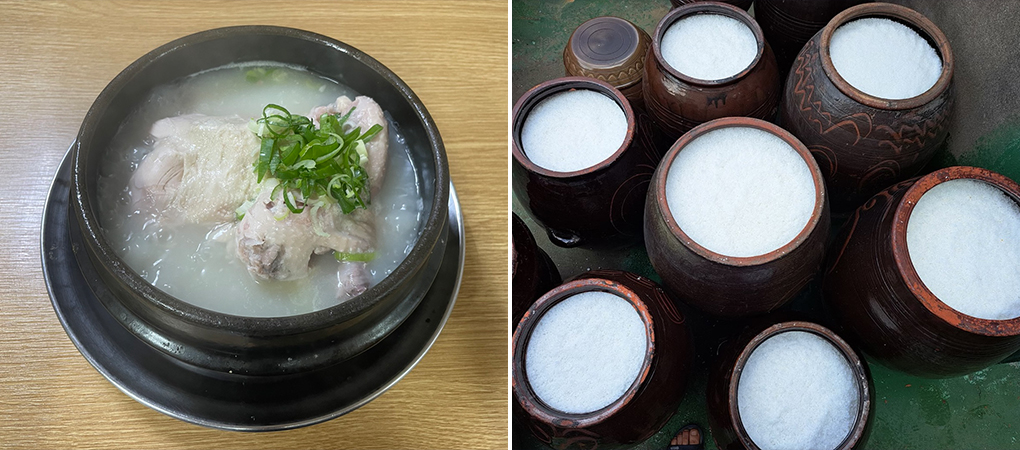
Jars of Aging Salt and Preparing Samgyetang
Can you tell us more about your second-best and third-best sellers,
the Perilla Seed Samgyetang and Braised Spicy Chicken?
For our Perilla Seed Samgyetang, unlike other places that thicken the broth with various ingredients, we use 100% pure perilla seeds. Perilla seeds are naturally rich and flavorful, which enhances the Samgyetang. Using high-quality ingredients and staying true to the original flavors ensures our dishes are always delicious.
Our braised Spicy Chicken is cooked in the same rich broth used for our Samgyetang, which gives it a deep, intense flavor. It’s a popular choice for groups dining together.
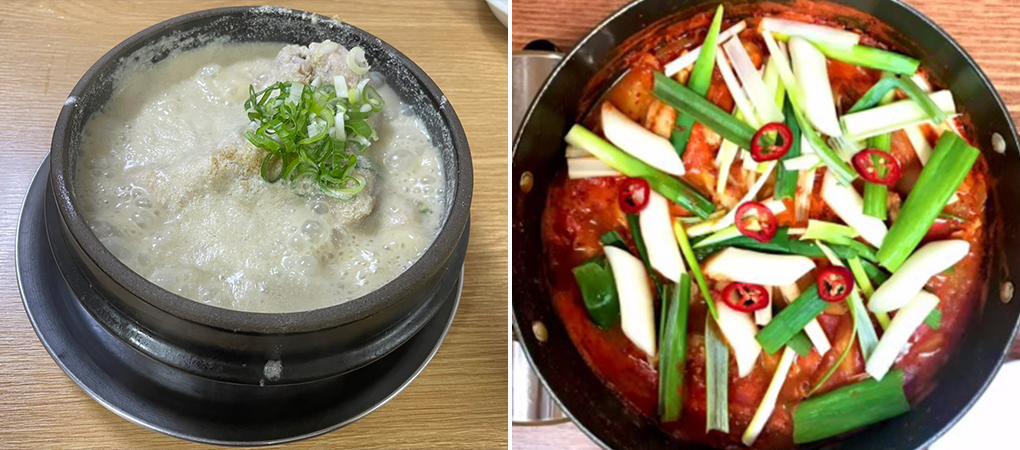
Perilla Seed Samgyetang and Braised Spicy Chicken
Do you have any hidden gems on your menu?
Our stir-fried octopus is a hidden gem. There are always some customers who can’t or don’t want to eat Samgyetang. Back when we only served Samgyetang, it was quite a predicament if someone in a group couldn’t have it—we even had to buy food from other restaurants sometimes. That’s when we decided to develop a menu for those who don’t eat Samgyetang. Stir-fried octopus seemed like a dish that would appeal to everyone. I tried stir-fried octopuses at various places, but most were too spicy for my taste. So, we toned down the spiciness to make it moderately hot. I was worried it might be too tailored to my taste, but the customers loved it. Now, it’s not only for those who can’t eat Samgyetang but also a popular choice for customers looking for a good side dish to enjoy with drinks.
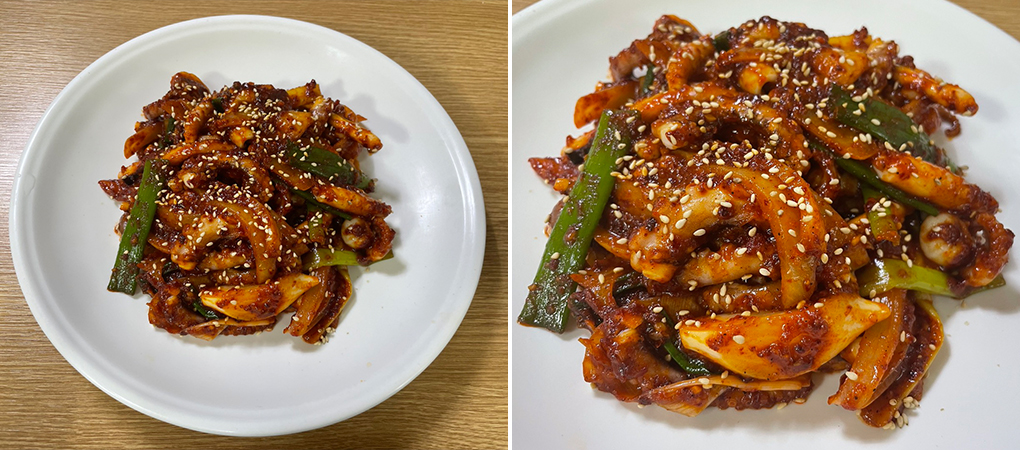
Our Hidden Gem: Stir-fried Octopus
I’ve heard your kimchi is quite popular, too.
Yes, we often hear compliments about our kimchi. We use the rice paste that remains after boiling chicken to mix with the kimchi, which adds a savory and umami flavor. We offer fermented radish kimchi and fresh napa cabbage kimchi to suit different tastes. We make the radish kimchi every two to three days and the fresh cabbage kimchi daily. Every evening, we salt the cabbage, and every morning, we mix it. We’ve never once bought kimchi; even when the price of napa cabbage soared to 20,000 won per batch, we made it ourselves. Kimchi is the only side dish we serve with Samgyetang, so it has to be good. We make sure to prepare it ourselves and serve it deliciously.
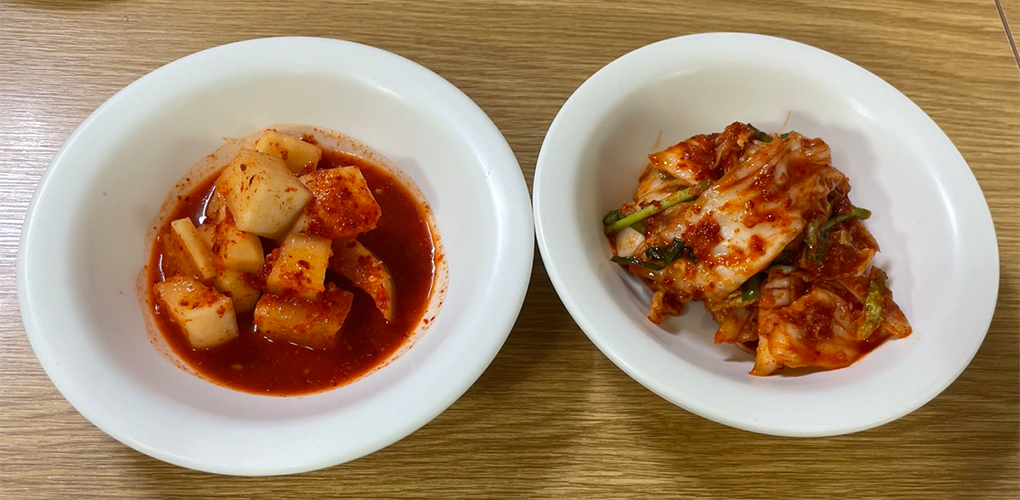
Kimchi Made Fresh Every Day.
I read in an article that Samgyetang is the number one dish with the highest price increase.
The average price of Samgyetang across the country is about 17,000 won. What’s your reason for keeping your prices reasonable?
Our Samgyetang is priced at 15,000 won, and we’re trying hard not to increase it further. Times are tough for everyone right now. We’re just grateful that we’ve been able to continue doing business this way, and we don’t need to ask for more. Even if our profit margins decrease slightly, we believe it’s better if more customers return to us.
You must be very busy during Boknal, which is the hottest summer day. How do you prepare?
On Boknal, we see three to four times more customers than usual, so we first prepare a large quantity of ingredients. We’re swamped from the early morning hours. Working in front of the stove during the hottest summer days can be daunting, and as Boknal approaches, we often feel a bit anxious. But once we get through that period, it feels manageable again. We’ve handled it well every year, so by now, we’re pretty used to it.
The Secret to Maintaining the Original Taste for Over 30 Years
What was the most challenging moment in your business?
The avian influenza outbreak in 1996 was, without a doubt, much harder than the COVID-19 pandemic. During COVID-19, we managed to stay afloat thanks to our regular customers, who continued to support us, often opting for takeout since Samgyetang is considered a nourishing food.
But during the avian flu outbreak, it was unimaginable. The first year was the toughest. No one knew what to expect, and many believed that eating chicken could be fatal. Although public perception gradually shifted over time, that first year was incredibly challenging. We seriously contemplated whether we should close the restaurant for good. As a last-ditch effort, we decided to develop new dishes besides Samgyetang. For 15 years, we had prided ourselves on serving only Samgyetang, but we introduced other items to the menu for the first time: loach soup and spicy catfish stew. Fortunately, the response was positive. We used the same rich broth made from simmering chicken feet, and our customers loved it. It helped us survive that difficult period. Once things improved, we removed loach soup and spicy catfish stew from the menu. Although they sold well, we felt it was important to stay true to our core offering—Samgyetang.
What conviction kept you going through tough times?
Maintaining the unchanging taste—the essence of our original recipe. To achieve this, we have to focus on the fundamentals. Now, our son is continuing the family business, and he, too, is committed to upholding that same principle.
Considering how you’ve kept the business going for over 30 years despite the challenges,
would you say you have a knack for entrepreneurship?
I'm not sure. I find spending my day here incredibly enjoyable. It’s like my own playground, in a way (laughs). As a full-time housewife, I was under a lot of personal stress. I always had a scowl on my face and lived on stomach medicine. But three years into running this restaurant, I stopped needing those medications. People around me often ask, 'Don’t you ever get tired of working?' But I never feel that way. I find joy both in the work and in chatting with our customers. Interestingly, friends who aren’t working often suffer from various aches and pains. Work seems to be a source of energy in my life.
You started this business with your husband, and now your son is involved,
making it a two-generation operation. What are the benefits of working with family?
One of the advantages is that when a couple works together, it saves on labor costs. Of course, spending so much time together means we often clash. Most of the time, it's over trivial matters, like ‘deciding which room to seat a group of customers in.’ But even when we butt heads, we have to talk things out to keep the business running, so we resolve things quickly. It’s both the upside and downside of working with a spouse. Since our son started working with us, the best part is that we can cover for each other. When I was the only one handling the kitchen, we had to close the restaurant if I couldn't work. Now, my son can manage the restaurant independently, giving me some much-needed time off. I’ve always loved pursuing hobbies, but before, I could only manage a quick trip to the local cultural center during our break times. Now, I can learn more about what I’ve always wanted to explore.
What kinds of things are you learning?
I’ve been learning sports dance for about 17 years now. I’ve also studied calligraphy and brush lettering. I even wrote the menu board myself. I’ve learned face painting, so I draw on my granddaughter's hand and make rice cakes for birthdays. I don’t want to grow old as just the 'restaurant lady,' so I’m picking up all sorts of skills.
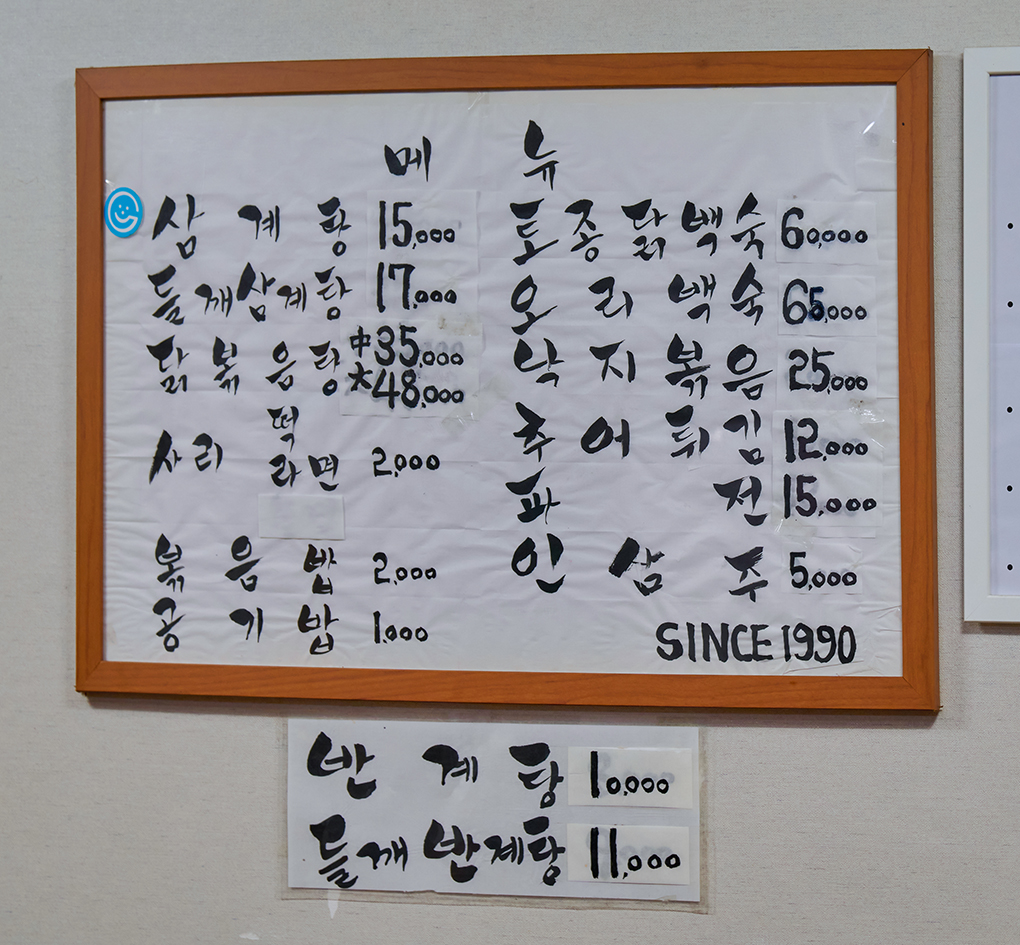
The Menu Board Handwritten by Jeong-im Han
What has been the driving force behind running this restaurant for over 30 years?
The most prominent driving force has undoubtedly been our regular customers. Their steady patronage has helped us get through the off-seasons and even the tough times during the COVID-19 pandemic.
I also think it’s partly due to my personality. No matter how hard a day is, I feel fine the next morning after a good night's sleep. My daughter often asks, ‘Mom, if you’re so tired, why do you get up so early?’ But once I’ve slept, I feel completely refreshed, so what can I do? (laughs)
Why do you think you have so many loyal customers?
It’s not that we do anything specific to manage this, but I think it comes down to our genuine ‘gratitude.’ I’m so thankful to everyone who comes to my place and enjoys their meal. I believe that appreciation somehow gets conveyed to our customers. Also, since our taste hasn’t changed, people keep coming back. They often tell us how much they appreciate the flavors as they remember, even if they haven’t visited in years.
When do you feel happiest running the business?
First, seeing our children grow up healthy and well. It makes me incredibly proud that they’ve grown up well and are now continuing the work we started. Secondly, it’s when our customers keep returning, without forgetting us over the years. Just today, we had customers nearly in their nineties, leaning on canes, come to see us, and I’m so grateful for that. What’s more touching is when they thank us for staying open for so long. When people who used to work in the area years ago, or those who have returned after many years abroad, remember our restaurant and make a point to visit, it’s incredibly heartwarming and makes me very happy.
"The Secret to My Skincare..."
Do many Amorepacific employees visit your restaurant?
In the old days, there were many beauty consultants at Taepyeongyang, and those ladies often came by. We also had a lot of visitors from Taepyeongyang Pharmaceuticals. Even now, many Amorepacific employees still come in, though I don't always recognize them. I usually find out when I notice their employee ID cards that say " Amorepacific." I must say that Amorepacific employees are always polite, refined, and impeccably groomed.
What does Amorepacific mean to you?
The secret to my skincare? (Laughs) I've only ever used Amorepacific products since the days when the company was still called Taepyeongyang. I used to love Mamonde; these days, I use IOPE and Sulwhasoo. Whenever I need to give a gift, I always choose Amorepacific. Their products seem to suit our skin best. I've never had a professional facial massage in my life. Working in front of the stove all summer enlarges my pores and isn't great for my skin, but I think using quality products has kept my skin looking good.
Amorepacific is a company to which we're very grateful. When they returned to their new headquarters, Yongsan became a vibrant area filled with trendy spots, drawing many young people. Even during the off-season and on weekends, many come here for Samgyetang. This street used to be nearly empty on weekends. I hear many other business areas are struggling, but our local economy has been relatively stable thanks to Yongridan-gil. I always feel thankful.
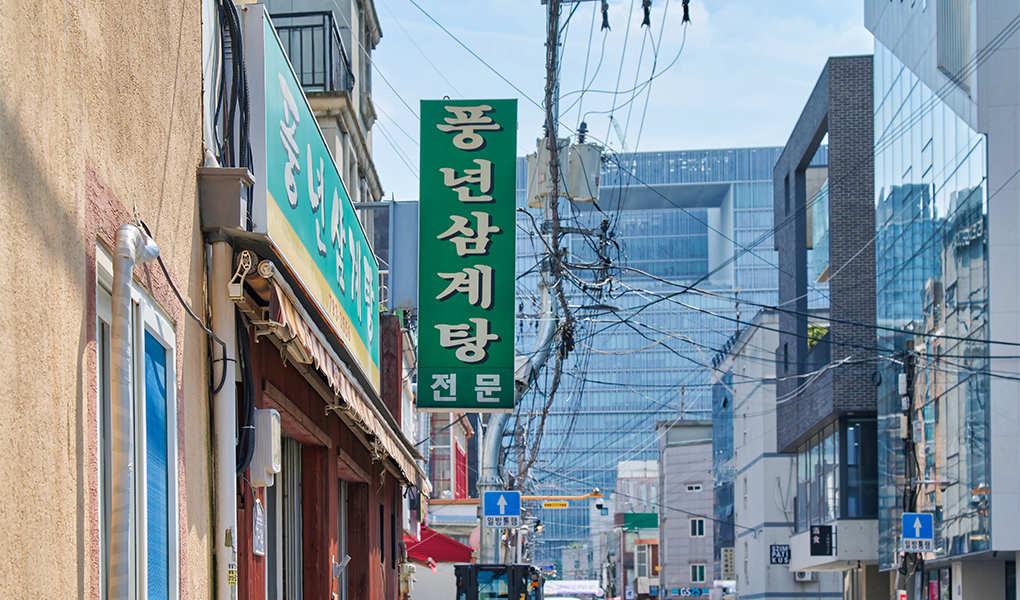
Amorepacific, as Seen from Poongnyeon Samgyetang
As a longtime resident of Yongsan, are there any hidden gems in Yongsan you'd recommend to Amorepacific employees?
There’s a spot I like to visit when I need to clear my mind. It’s a true hidden gem. You'll find a staircase if you head up towards the Military Central Church and take a right. Climb those steps, and you’ll reach a hill with a pavilion. It’s a quiet place that not many people know about. You can sit on a bench, enjoy the breeze, listen to the birds, and sometimes even meditate. It really helps to calm a cluttered mind. I’d recommend it to anyone feeling stressed or troubled at work.
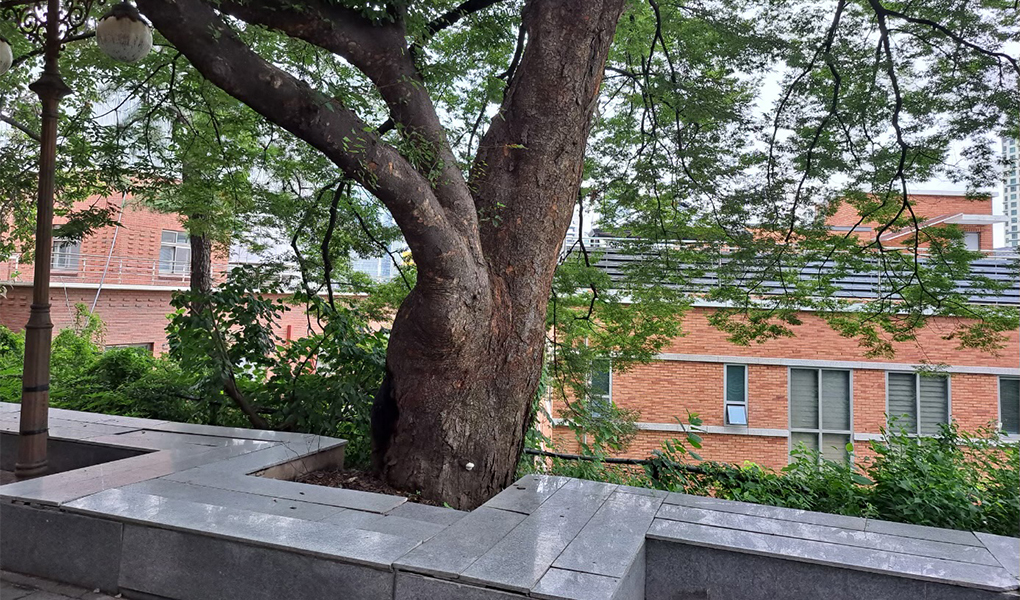
Jeong-im Han’s Favorite Hidden Spot in Yongsan
What does ‘happiness’ mean to you?
The greatest happiness is having my family safe and healthy. What could be more precious than that? The second is being able to continue working and finding healthy stimulation and movement through my work. That’s my happiness.
If you could return in time, would you still open a Samgyetang restaurant?
Yes, I would. It’s what I know best and most capable of doing. Having done this for so long, I've developed a sense of pride in my expertise. If I could go back, maybe I’d avoid some mistakes and find a quicker path.
What do you envision for yourself in ten years?
I want to keep working as long as my health allows. Ten years from now, I hope I'll still be here, doing what I do. It would also be great if I could continue indulging in my hobbies as much as I like.
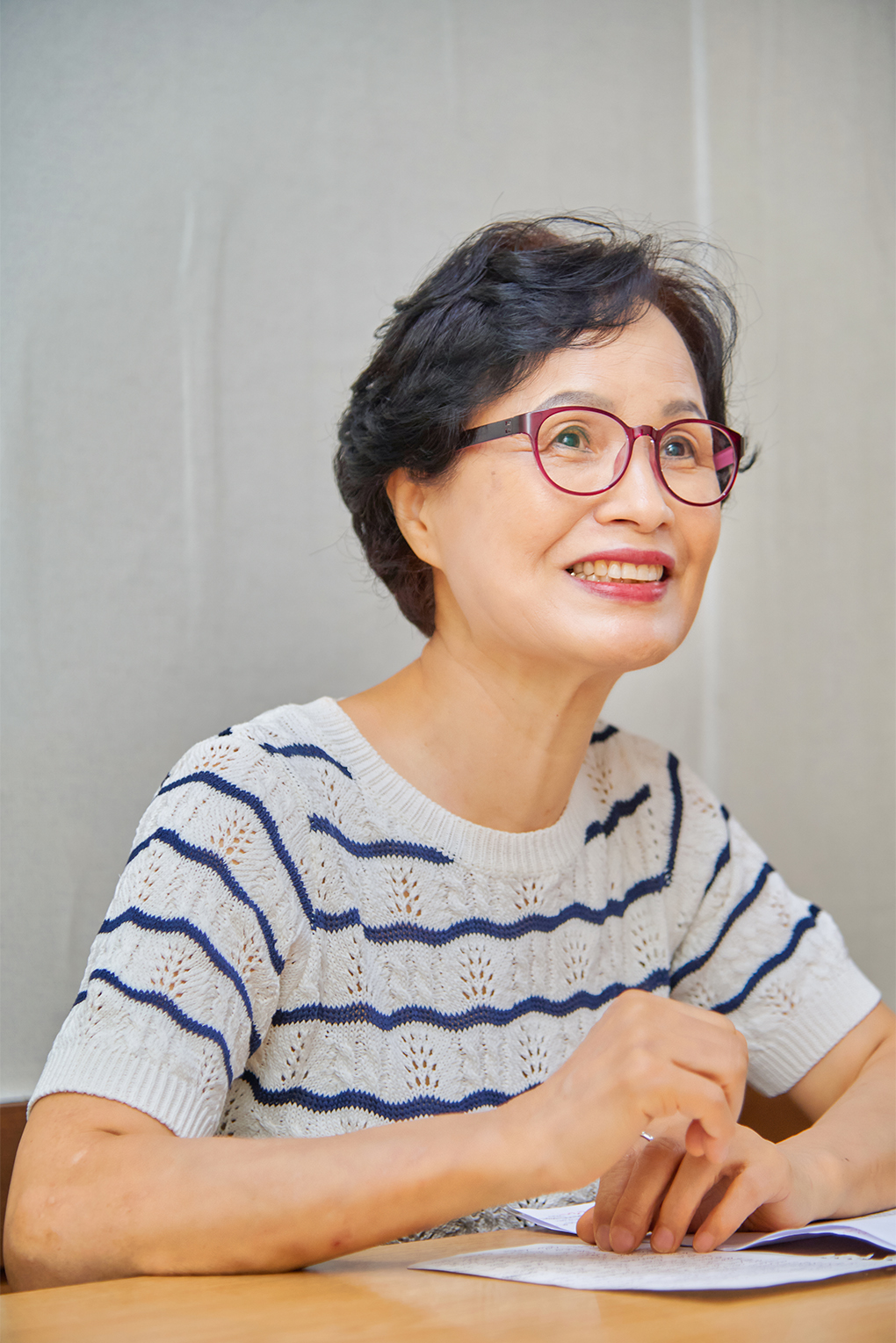
Interview with Jeong-im Han at Poongnyeon Samgyetang
epilogue
Jeong-im Han's positive energy, as she describes ‘her restaurant as her playground’ and says that ‘working is the secret to staying youthful,’ was palpable. We hope Poongnyeon Samgyetang, which has faithfully preserved its original flavor since 1990, will continue to be a beloved part of Yongsan for many years.
‘100 Hangang-daero’ brings you interviews with business owners around Amorepacific, exploring the value and meaning of work through stories of passion, perseverance, and overcoming adversity.
Interview Hye-won Shin (Papervore)
Photos Design Mong
Planning Amorepacific Communications Team
-
Like
3 -
Recommend
3 -
Thumbs up
2 -
Supporting
1 -
Want follow-up article
1



